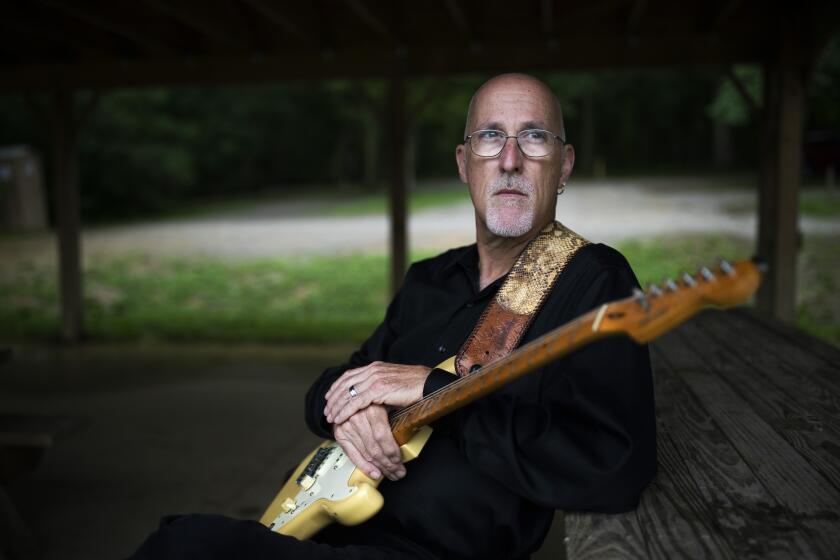Everyone’s crazy about Bo Burnham’s Netflix special, but is his music actually good?
- Share via
When Bo Burnham broke out back in the early days of YouTube — his first viral video, from 2006, showed him in his childhood bedroom, performing an original song about how his whole family thinks he’s gay — his music rarely felt like more than a vehicle designed to carry his comedy.
A kind of rinky-dink show tune minus the show, “My Whole Family…” offered little in the way of a memorable melody, nor was its arrangement, plunked out by the teenage comedian on a cheap keyboard, anything to savor. The song had clever (if callow) rhymes, to be sure, but even those relied on the clip’s grainy pre-iPhone footage to get over: You had to see Burnham arching his eyebrows to understand exactly when he was making a particularly cringe-y joke.
The formal relationship in Burnham’s work — music in the service of comedy — was more or less maintained as he ascended from YouTube glory to Comedy Central stardom, which is one reason his 2010 album was called “Words Words Words” and not “Notes Notes Notes.” (Burnham’s rise was so speedy that he turned down an invitation to study experimental theater at NYU to go pro at age 18.) But the relationship shows signs of change with “Inside,” his much-discussed Netflix special that dropped over Memorial Day weekend and last week spawned a standalone collection of songs available on streaming platforms including Spotify.
For the first time, you can credibly argue that Burnham, now 30, has used comedy as a vehicle to deliver music.

Conceived and almost entirely executed, we’re told, by Burnham on his own during the COVID-19 pandemic, “Inside” charts the slow coming-apart of a stand-up comedian self-isolating in a small guesthouse situation. There’s no live audience, of course, but we the television audience watch as he does bits — and writes, tries out and discards other bits — about technology and racism and mental health, nearly all of which are presented as songs in styles as varied as synth-pop, doo-wop and campfire folk.
Some of it relies, no less than the old YouTube stuff did, on Burnham’s visuals. He performs the scalding “How the World Works” as a duet with a woke sock puppet, for instance, and uses a 30-second snippet called “Unpaid Intern” as the basis for a longer segment skewering internet reaction videos (and the self-obsession they foster).
Dozens of protesters gathered outside Agoura Hills’ Canyon Club concert venue, where Foo Fighters held a full-capacity show only for vaccinated fans.
Yet many of “Inside’s” 20 tunes play outside the special — and not only in an artistic sense. According to data published Wednesday by the music-biz trade journal Hits, sales-and-streaming activity for the “Inside” album has it running neck-and-neck with Maroon 5’s new LP in the race for next week’s album chart.
“Inside (The Songs)” has already topped Billboard’s comedy tally, and indeed Burnham’s songs are comedic in nature, which no doubt will lead some listeners to dismiss them out of hand as novelty tunes that couldn’t possibly have anything serious to say. What other narrative mode, though, would better suit the bleak absurdity of Burnham’s subject matter?
In “That Funny Feeling” and “White Woman’s Instagram” and “Welcome to the Internet,” he describes the dehumanizing experience of an online life with good jokes about corporate-virtue signaling and how-to-build-a-bomb videos; you laugh, yes, because the jokes are funny. But they’re also masterfully arranged in a way that catches the sickening rhythm of a digital content flow certain someday to drown us:
The surgeon general’s pop-up shop, Robert Iger’s face
Discount Etsy agitprop, Bugles’ take on race
Female Colonel Sanders, easy answers, civil war
The whole world at your fingertips, the ocean at your door
That’s songwriting as sharp as anything by such respected social satirists as Randy Newman or Father John Misty, and that’s before Burnham has even gotten to the end of the verse in question, where he rhymes “‘Carpool Karaoke,’ Steve Aoki, Logan Paul” with “A gift shop at the gun range, a mass shooting at the mall.”
Hilarious, right?
From guitar techs to road managers to crew chiefs, a year without work devastated live music’s behind-the-scenes workers, and many may never recover.
Comedy rock, or whatever we might call it, faces a built-in durability challenge, which is providing a reason to keep listening after you’ve heard the punch line. Jokes are built to exploit the fact that you don’t know where they’re going; great pop songs are supposed to be experienced again and again. Threading that needle is tricky work: For every Tenacious D, whose mock-hair-metal jams ooze meathead sincerity, you get a Flight of the Conchords, whose arch acoustic ditties need some dramatic scaffolding; for every “I’m on a Boat” by the Lonely Island, you get ... all the other songs by the Lonely Island.

Burnham succeeds by creating songs that don’t require the context of a sitcom or a video or even a familiarity with the details of his life and career (though each of those certainly adds value); at his best, he’s simply doing what songwriters do in examining complicated ideas with humor and wisdom.
Hooks, too: Burnham’s composition and production skills — evidently he functions as a one-man band — have expanded and improved along with his writing. Where his early songs felt thin both texturally and harmonically, here he gets real emotion out of the pulsating synths in “FaceTime With My Mom (Tonight)” and the throbbing beat in “Sexting,” which is about 85% toward being a Post Malone song. (Crucially, Burnham never seems to be condescending to the various pop idioms he takes up throughout “Inside.”) The feeling in these tunes isn’t just in the lyrics but in the music — an important distinction from, say, “Weird Al” Yankovic’s comedic parodies, in which the music is meant to get out of the way of the words. If anything, the result has more in common with someone like the late Adam Schlesinger of Fountains of Wayne, whose wit always rivaled his ease in any genre.
What still constrains Burnham is his voice; it remains the brittle, somewhat pinched instrument he began using more than a decade ago on YouTube. Yet even that would-be liability feels somehow essential to his deeply personal music, as key to “Inside” as the goofy exuberance of Lin-Manuel Miranda’s rapping was to “Hamilton” (whose songs were improved not at all when famous hip-hop and R&B stars cut them for “The Hamilton Mixtape”).
Listening to “Inside (The Songs),” you can wonder what it might sound like to hear a “real” singer do “That Funny Feeling” or “White Woman’s Instagram” or “All Eyes on Me,” a bleary and haunting trap-soul ballad about Burnham’s struggles with anxiety. Perhaps they’d sound more muscular; for sure they’d get closer to the radio. But then you realize that what gives these songs their weight is the presence of the guy dying to make us laugh.
More to Read
The biggest entertainment stories
Get our big stories about Hollywood, film, television, music, arts, culture and more right in your inbox as soon as they publish.
You may occasionally receive promotional content from the Los Angeles Times.













